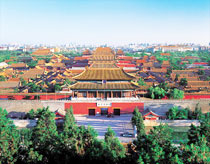Forbidden City
 The Forbidden City situated exactly in the heart of the municipality was home to 24 emperors of the Ming and Qing Dynasties. The construction of the grand palace started in the fourth year of Emperor Yongle of the Ming Dynasty (1406) and ended in 1420. In the ancient time, the emperor claimed to be the son of the heaven and therefore their supreme power was conferred upon them from the heaven. Their residence on the earth was built as a replica of the Purple Palace where the God lived in the Heaven. Such divine place was certain forbidden for the ordinary people and it is why the Forbidden City is so called. The museum is a real treasures house of Chinese cultural and historical relics, recognized as one of the most important five palaces in the world (the other four are the Palace of Versailles in France, the Buckingham Palace in the UK, the White House in the US and the Kremlin in Russia). The splendid architecture of the Forbidden City represents the essence and culmination of the traditional Chinese architectural accomplishment. In 1961 the Palace Museum was listed as one of the important historical monuments under the special preservation by the Chinese central government and in 1987, it was nominated as the world cultural heritage by the UNESCO. The Forbidden City situated exactly in the heart of the municipality was home to 24 emperors of the Ming and Qing Dynasties. The construction of the grand palace started in the fourth year of Emperor Yongle of the Ming Dynasty (1406) and ended in 1420. In the ancient time, the emperor claimed to be the son of the heaven and therefore their supreme power was conferred upon them from the heaven. Their residence on the earth was built as a replica of the Purple Palace where the God lived in the Heaven. Such divine place was certain forbidden for the ordinary people and it is why the Forbidden City is so called. The museum is a real treasures house of Chinese cultural and historical relics, recognized as one of the most important five palaces in the world (the other four are the Palace of Versailles in France, the Buckingham Palace in the UK, the White House in the US and the Kremlin in Russia). The splendid architecture of the Forbidden City represents the essence and culmination of the traditional Chinese architectural accomplishment. In 1961 the Palace Museum was listed as one of the important historical monuments under the special preservation by the Chinese central government and in 1987, it was nominated as the world cultural heritage by the UNESCO.
The Forbidden City is the best preserved imperial palace in China and the largest ancient palatial structure in the world. Because the emperor believed that, his palace was in the center of the earth, so the palace was symmetrically built along the north-south central axis of the capital city of Beijing. The whole imperial city extends from the Drum Tower and the Bell Tower in the north to Yong Ding Men, or the gate of Permanent Peace and Stability in the south. Despite of countless complex structures and buildings, the imperial city is know for its harmonious layout and deemed to be the summit that the ancient Chinese architecture had ever reached.?
The Forbidden City covers an area of about 72 hectares with a total floor space of approximately 150, 000 square meters. It is claimed that the Forbidden City has a total of 9,999 rooms, just one less than the Purple Palace in the heaven. However, the fact is that according to the statistics in 1973, it consists of 90 palaces and courtyards, 980 buildings and 8,704 rooms. To represent the supreme power of the emperor from the God and the place where the he lived being the center of the world, all the gates, palace and other structures of the Forbidden City were arranged on both sides of the south-north central axis. The City falls into two parts: the outer court and the inner palace. The outer court is made up of three main buildings (Tai He Dian, or the Hall of Supreme Harmony, Zhong He Dian, or the Hall of Middle Harmony and Bao He Dian or the Hall of Preserving Harmony) were the emperors attended the grand ceremonies and conducted the state affairs with the annex halls on either side. While the inner palace is composed of the rear three main structure of the City, namely, Qian Qing Gong, or the Palace of Heavenly Purity, Jiao Tai Dian, or the Palace of the Union and Peace and Kun Ning Gong, or the Palace of Earthly Tranquility. Besides the three rear main buildings are the six eastern palaces and six western palaces, where the emperor used to handle every day affairs and was the living quarters for the emperor, expresses and concubines. For security the Forbidden City is enclosed by a 10 meters high city wall, which has a circumference of 3, 430 meters. At each corner of the rectangular Forbidden City, there stands a magnificent watchtower, which was heavily guarded in the past. And around the outskirt of the city a moat goes as the last defense work.
Tips:
1. The Fobidden City is now undergoing large-scale renovations which are expected to be completed till 2020. The Forbidden City will remain open to visitors during the renovations, but there may be some temporary inconvenience, for which we apologize.
2. The Forbidden City will adopt E-tickets
Troubled by excessive visitors, the Palace Museum, or Forbidden City, in Beijing will adopt an electronic ticket-checking system from May onwards to control its crowd flow. |